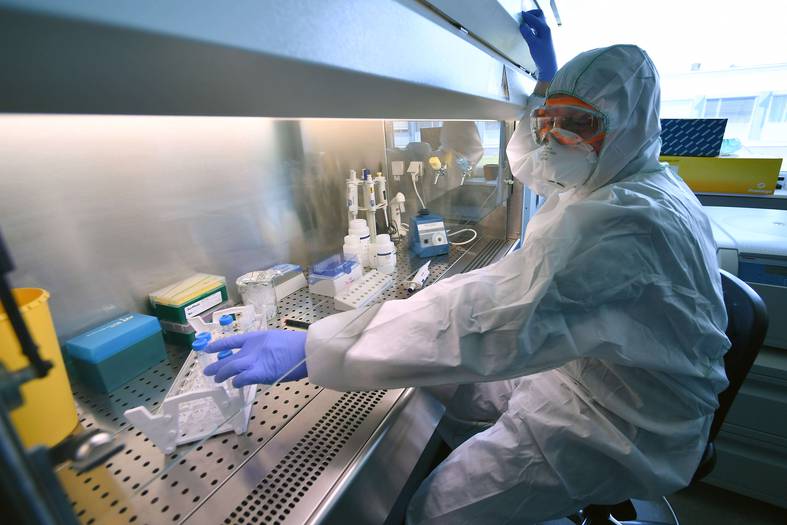William G. Dundon, Consultant, Molecular Biologist, Animal Production and Health Laboratory, Joint FAO/IAEA Division of Nuclear Techniques in Food and Agriculture prepares the extraction of the virus genome for an rRT-PCR test of COVID-19. Image credit: Dean Calma / IAEA
As of May 26, 2020, the virus that cases COVID-19 disease is affecting 213 countries and territories with total cases of 5,590,376 and death of 347,915 around the world. To limit viruses from spreading, the person that is affected by COVID-19 must be detected on time and then isolated so the virus can not spread to others and those already transmitted could be tracked back. One of the most accurate laboratory methods for detecting, tracking, and studying the coronavirus is real-time RT-PCR (rRT-PCR).
To use this technology, support and expertise were provided by the International Atomic Energy Agency (IAEA), in partnership with the Food and Agriculture Organization of the United Nations (FAO). "The Agency takes pride in its ability to respond quickly to crises, as we did in the recent past with the Ebola, Zika and African Swine Fever viruses," said Rafael Mariano Grossi (Director General ) in a statement to the IAEA Board of Governors. "Contributing to international efforts to deal with the coronavirus will remain a priority for me as long as the outbreak persists."
What is Real-time RT-PCR?
Real-time RT-PCR stands for real-time Reverse Transcription–Polymerase Chain Reaction and is primarily used for detecting the presence of specific genetic material (mainly RNA) in any pathogen, including a virus. This nuclear-derived technique originally used radioactive isotope markers to detect targeted genetic materials but by subsequent refining, the radioactive isotopes have been replaced by special markers, most frequently fluorescent dyes. While the traditional RT-PCR only provides results at the end of the process, this rRT-PCR scientists can see the results almost immediately while the process is still ongoing.
Real-time RT-PCR has risen to become the benchmark technology for the detection and/or comparison of RNA levels for several reasons like:
it does not require post PCR processing.
a wide range (>107 -fold) of RNA abundance can be measured.
it provides insight into both qualitative and quantitative data.
How is the COVID-19 Virus/ Detected using Real-time RT-PCR?
A sample of an infected person is collected from an area like a nose or throat. Particularly, the nose and throat are the areas where the coronavirus gathers. The sample contains proteins and fats and also redundant that is not needed for the coronavirus test so they are removed from the sample by treating the sample with several chemical solutions so the sample only contains the person's genetic material: RNA and also the RNA of coronavirus.
Now a specific enzyme is used to generate DNA from RNA by a process called Reverse Transcription (RT). Scientists/Health personnel then add additional short fragments of DNA that are complementary to specific parts of the transcribed viral DNA and if the virus is present in the sample then these fragments will attach themselves to the target section of the viral DNA. Here, some of the added genetic fragments are used for building DNA strands during amplification, while the others are used for building the DNA and adding marker labels to the strands, which are later used to detect the virus in the sample.
Now, here comes the role of the rRT-PCR machine. The mixture is then placed in an rRT-PCR machine. The rRT-PCR machine is designed as it cycles through temperatures that can heat and cool the mixture that is placed in it. These heating and cooling of the sample trigger specific chemical reactions that create new, identical copies of the target sections of viral DNA. The sample inside the rRT-PCR machine goes cycles of this process and continuously copies the target sections of viral DNA. One interesting thing about this machine and its process is in each cycle the target sections of viral DNA doubles i. e. two copies become four, four copies become eight, and so on. A standard rtRT-PCR usually creates around 35 billion new copies of the sections of viral DNA from each strand of the virus present in the sample in about 35 cycles.
Now, the marker labels that came from the added genetic fragments attach to the copies of the sections of DNA strands and they release a fluorescent dye. This released fluorescent dye is measured by the computer's machine and is displayed in real-time on the screen. After each cycle, the amount of fluorescent dye is tracked by the computer and when this amount goes over a certain level of fluorescence then it will confirm that the initial sample contains the virus.
Also, rRT-PCR let us estimate the severity of the infection by monitoring how many cycles it takes to reach this level and scientists have defined: the fewer the cycles, the more severe the viral infection is.
This whole process of diagnosis will give a result within three to hours which is an important achievement compared to other laboratory methods that usually take six to eight hours. So compared to other laboratory methods real-time RT-PCR is significantly faster and also has a lower potential for contamination or errors as the entire process can be done within a closed tube and more importantly it continues to be the most accurate method available for detection of the coronavirus.
There is no confusion that this method of detecting the virus is more accurate and more efficient, but this method is not useful in the case of detecting the past infection as viruses will only be present in the body for a specific window of time.
